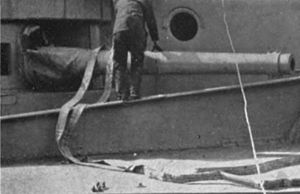BL 6 inch Mk XII naval gun
| BL 6 inch gun Mk XII | |
|---|---|

Casemate gun on HMS Warspite after the Battle of Jutland, June 1916
|
|
| Type | Naval gun |
| Place of origin | United Kingdom |
| Service history | |
| In service | 1914–1945 |
| Used by | British Empire |
| Wars | |
| Production history | |
| Designer | Vickers |
| Designed | 1913 |
| Manufacturer | Vickers |
| No. built | 463 |
| Specifications | |
| Weight | 15,512 pounds (7,036 kg) barrel & breech |
| Barrel length | 270 inches (6.858 m) bore (45 cal) |
|
|
|
| Shell | 100 pounds (45.36 kg) Lyddite, Armour-piercing, Shrapnel |
| Calibre | 6 inches (152.4 mm) |
| Breech | Welin interrupted screw |
| Recoil | Hydro-spring, 16.5 inches (420 mm) |
| Elevation | −7°–30° |
| Rate of fire | 5-7 rpm |
| Muzzle velocity | 2,825 feet per second (861 m/s) |
| Maximum firing range | 19,660 metres (21,500 yd) |
The BL 6 inch Gun Mark XII was a British 45 calibres naval gun which was mounted as primary armament on light cruisers and secondary armament on dreadnought battleships commissioned in the period 1914 - 1926, and remained in service on many warships until the end of World War II.
This was a high-velocity naval gun consisting of inner "A" tube, "A" tube, wound with successive layers of steel wire, with a jacket over the wire.
It superseded the 45-calibres Mk VII gun and the longer 50-calibres Mk XI gun which had proved unwieldy in light cruisers due to its length, and was Britain's most modern 6-inch naval gun when World War I began.
It was superseded as secondary armament on new battleships in the 1920s by the 50-calibre 6-inch Mk XXII gun, and as main armament on new light cruisers in the 1930s by the 50-calibre 6-inch Mk XXIII gun.
Guns were mounted in the following ships :
During WWII some Mk XII guns were used in emergency coast defense batteries.
This gun generated a higher pressure in the chamber on firing compared to preceding 6-inch guns such as Mk VII and Mk XI. This necessitated use of special shells capable of withstanding a pressure of 20 tons per square inch on firing, which had "Q" suffixed to the name. World War I shells were marked "A.Q." denoting special 4 C.R.H. shells for this gun.
...
Wikipedia
